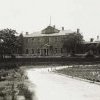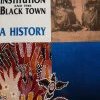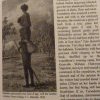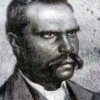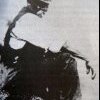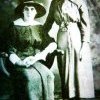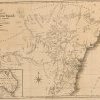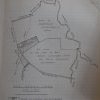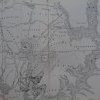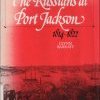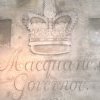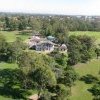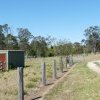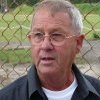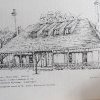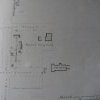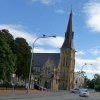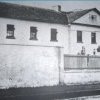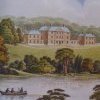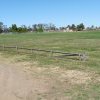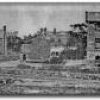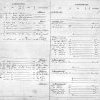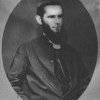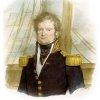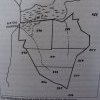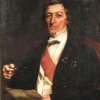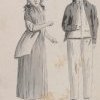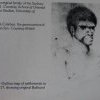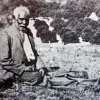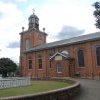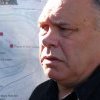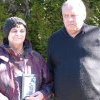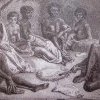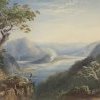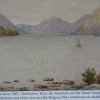1820s
1820
Ballandella (Jane) is captured from Wiradjuri land and brought back to Windsor. John Luke Barber and Jane have children Samuel Barber in 1820, Joseph Barber in 1821, William Barber in 1823, Lucy Barber in 1825, and Andrew Barber in 1828, Elizabeth in 1833, Mary Ann in 1840 and Maria in 1850. Jane dies and John Barber marries a European woman. They live on Sackville Reserve. The children of John Luke Barber and Elizabeth are John, George Henry, Alfred Ernest, Maud E, Aurelia, Clara E G, Adeline L M, Susannah, Bertha B, Nina A, Maria A, Pearl, Christina P (Chrissy) Selina J, William J, Susannah and several infants who died. John Luke Barber fathers at least 21 children.
1821
Two Koori couples from the Native Institute marry. An Institute plan is to encourage inmates to marry the boys and the girls from the Native Institution to each other, to form a nucleus of stable Europeanised Aboriginal settlers. The Russian astronomer Ivan Simonov sees the girls from the Native School wearing their clean white dresses and singing hymns in church. (Glynn Barratt (translator), The Russians at Port Jackson 1814-1822, Canberra: AIAS, 198. p. 49). More than 300 Aborigines attend the annual Native Conference at Parramatta.
The Native Institute plan is for the boys and the girls from the institute to marry each other, and thus form a nucleus of stable Europeanised Aboriginal settlers. Two Aboriginal couples marry in 1821 (Polly to Michael Yarringguy and Betty to Bobby Nurragingy). They settle on land near Creek Jemmy’s land, where they are joined by three other families. They receive 3 ha. each (J.L.Kohen, Aborigines in the west. Prehistory to Present, 1985, np.
1822
Kitty Colebee is a student at the Parramatta Native Institution, of the Cannemegal (Warmuli) group. She marries Colebee in 1822. (Macquarie ‘s memorandanda list of natives at Native Institution 28/12/1819 ml a772 p 151) Kitty is admitted to Native Institution in 1814 at 5 yrs. After marrying Colebee the couple settle in Blacktown on a small farm of their own. They have a son Samuel, baptised RC at Richmond 1827. Both parents are said to be of the Prospect tribe. Kitty is named on the Blanket lists. Her other son is James Bowen Budsworth whose father is Englishman, Joseph Budsworth. James’ daughter is Cicely Lucy Budsworth marries Ephraim Joseph Rose, great grandson of Thomas and Jane Rose, first free settlers to arrive in Australia in 1793. Kitty and her children live around the Tamworth, Coonabarabran area. Cicely Lucy was born at Blackville near Quirindi.
The Native Institute is shifted from Parramatta to an area soon called Blacktown, though the location is actually Plumpton. At ‘Blacktown’ a large building incorporating a chapel is erected, standing for more than century. Videos, ‘The future of the Blacktown Institute’; ‘We lost it once, we don’t want to lose it again’.
Maria leaves the Native Institution and marries the Koori man, Dicky, a son of Bennelong. Dicky dies in 1823. Among the carpenters employed in constructing the new buildings is Robert Lock (Locke), a convict. He marries Maria in 1824 at St Johns Church Parramatta or St Bartholomews at Prospect. Their marriage is the first officially sanctioned marriage in the colony between a Koori woman and European convict. Because he is still a convict Robert is assigned to Maria and placed under her supervision. After their marriage they farm on the Colebee grant near the new Blacktown Native Institute. Maria’s direct descendants include Viney Everingham, Martha Docker, Ellen Alderton, and Val Aurisch. (For videos on Aunty Val Aurish, see The Gully. See also, ‘Why isn’t there any mention of an Aboriginal woman being married in this church?’
1823
At the Native Settlement we shall be in great need of clothes, to cover the nakedness of the people. Send as well as a few tomahawks not made in the shape of an axe.”
Walker describes a tribal battle near the Native School: “The man who threw the spear that wounded a boy had to stand punishment for his transgressions. 300 or 400 Blacks assembled to do their utmost. He defended himself against a host of spears with a shield about I foot broad and 3 foot long”. His friends then must offend his punishers, one of them had his skull fractured. … They then “made it up… As many were able afterwards, they got drunk with either grog or peach cider.”
1824
Blacktown Native Institution is starved of support, has few children, and is closed down. The few remaining children are transferred to the Parramatta Orphan school. This imposing stone building on the banks of the Parramatta river is cold and run like a prison. Many children both Koori and European die from influenza , measles and typhoid. In one year in the 1840s, over one hundred infants perish.
Windradyne, the famous and feared warrior of the Wiradjuri nation, visits Parramatta to meet with Governor Thomas Brisbane. The Sydney Gazette (using the British name for him of Saturday) write of him:
He is one of the finest looking natives we have seen in this part of the country. He is not particularly tall, but is much stouter and more proportionably limbed than the majority of his countrymen; which, combined with a noble looking countenance, and piercing eye, are calculated to impress the beholder with other than disagreeable feelings towards a character who has been so much dreaded by the Bathurst settler. Saturday is, without doubt, the most manly black native we have ever beheld---a fact pretty generally acknowledged by the numbers that saw him.”
Reverend William Walker quotes Reverend Richard Watson from Walter Lawry, Secretary of Wesleyan Mission Society: “at the Cowpastures the Blacks have been fighting, a few were killed, several disastrously wounded. …The Blacks sent (evidence) to the governor by the hands of Major Ovens, …traversing the woods in their tribes living in a kind of domesticated manner. … We must use our utmost endeavors to select the most promising youth from the tribes …and keep them under a course of tuition and religious instruction”. (Bonwick Transcripts 52 folio 224)
Walker to Reverend Watson about teaching at the Blacktown Native Institute: “Of the Government Institution I shall take a part. The girls will fall to my lot, the boys to Mr Cartwright’s. The government will give me twenty pounds per annum per child but only a probation for the children. If after one year every expectation of two or three men (public examiners) is not realised, then the child will be placed in the Orphan Schools.” A group of local respectable men attend the annual public examinations.
Reverend Walker: “Mr Lawry (Superintendent of the Orphan School, Parramatta, which contains a number of Koori children) returns to England. He has had much painful exertion of mind, and been the subject of severe temptation.” (Lawry was accused of prostituting the girls at the orphan school to local men.)
The explorer D’Urville describes a complicated pay-back ceremony, possibly near Newtown, attended by nearly all the Sydney clans. Part of the day seemed to D’Urville to be more like a fighting tournament than a free-for-all. The clan chiefs warned the whites to keep well out of the road for spears were being thrown in all directions. (J.L.Kohen, The Darug and their Neighbours, Darug Link, 1993, pp. 72-4)
1825
In Wilberforce, Edward Reynolds a ticket of leave man, adopts a Darug 17 year old young woman into his childless family. She is named Elizabeth Wilberforce baptised in that year. However by 1829 she dies. V 1829 82702c. Edward Reynolds and his brother Richard Reynolds have farms that are under attack by Branch Jack and his warriors.
Governor Sir Thomas Brisbane writes: “I have intended to employ missionaries for the Aborigines. I have ordered that 10,000 acres of land [about 7000 ha.] situated in the said colony be reserved for the use of the Aborigines. The (authorities) are empowered to convey for a term of years or in tail [entail], or free simple any portion not exceeding 30 acres to any Aboriginal native man or youth or woman, or the offspring of Black or white parents. Subject to this consideration that the same land shall not be sold or given to any white person.”
Earl Bathurst writes in Government Dispatches, 1823-32 p. 104: “Wesleyan Missionary couple Reverend M Walker and Mrs Walker, engaged for 12 months under my own eye in the instruction of the Black Boys of the late Native School…I was anxious also to try the experiment of the white and black natives of this colony imbibing their earliest intellectual and religious ideas under a common roof.”
1826
The Sydney Gazette: (23 July) The [Mulgoa] blacks are willing to work if well fed; but the generality of settlers…think these unfortunate people are sufficiently remunerated for their day's labour by a gift of a small piece of tobacco and a drink of sour milk. (M. Martin, On Darug Land. An Aboriginal Perspective, 1988, p. 77)
Cunningham writes of the Mulgoa people, Many of these men work upon the settlers’ farms at odd jobs throughout the year, and also at harvest of late ... A gentleman of Mulgoa...had, in 1826, 30 acres of wheat reaped by a party of them in 14 days as well as by Whites. They were always out before the Whites in the morning, and were fed and paid a regular price for their labour, the gentleman giving it as his opinion that the chief cause of dislike to work on the part of the Cumberland Blacks is their being cheated by the small convict settlers’. (M. Martin, On Darug Land. An Aboriginal Perspective, 1988, pp. 76-7)
1827
1828
Birth of Andrew Barber. He was well liked in the Windsor area, the Windsor and Richmond Gazette reported that Andrew was “one of the best known residents of the district” He always took pride in his appearance and was courteous and obliging. One local Farmer remarked that, "Andy could turn his hand to anything and did as much work as a man and a half. Ploughing, fencing and horse breaking, he performed with equal facility". (J. Brook, Shut out from the World, pp. 58-9)
1829
Koori people at times spend the night in rocks at the top of the range east of Thornleigh. It is often very damp and cold near the extremity of the ridge [Pacific Highway] which divides Cowan and Berowra Creeks. Overlooking the Hawkesbury is a wide mass of carved flat rock used to sharpen iron tomahawks.











